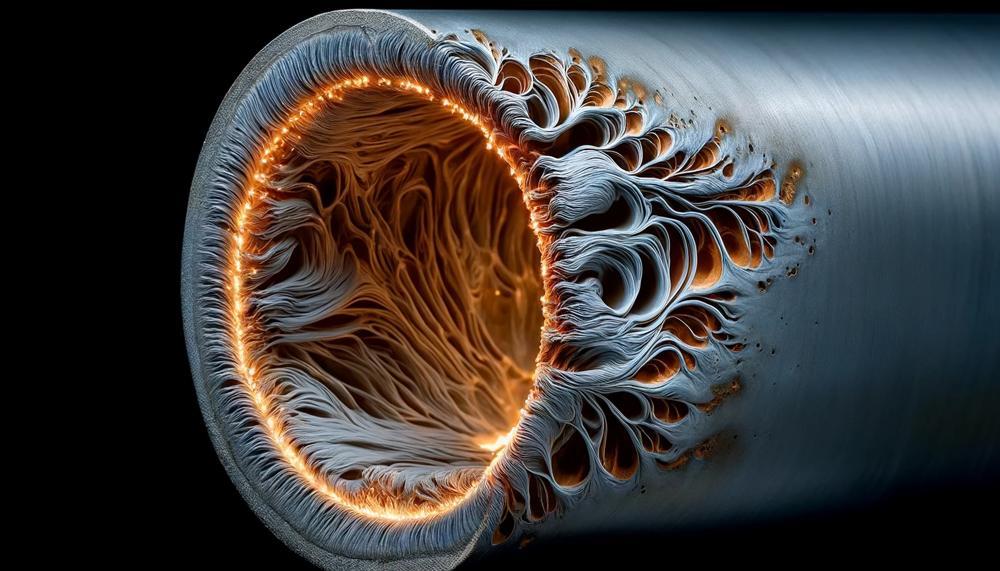Welding, an art and science of joining metals, plays a crucial role in various industries, from automotive to construction. Yet, one of the common challenges welders face is porosity – those pesky air bubbles that compromise the strength and appearance of the weld. But fear not, whether you’re a seasoned pro or a budding welder, understanding and preventing porosity can elevate your welding game to new heights.
In this blog post, we delve into the nitty-gritty of porosity in welding, unveiling the main culprits behind it and, more importantly, how to outmaneuver them. We’ll guide you through a series of strategies designed to mitigate porosity, ensuring your welds are not only aesthetically pleasing but structurally sound.
So, how to prevent porosity in welding?
When trapped gas escapes from the weld metal, it creates porosity in the form of cavities or bubbles. You may avoid porosity by:
- Get the foundation material ready: Before welding, clean the base metal of any dirt, moisture, oil, paint, and grease. To clean the surface, you may use a wire brush or grinder.
- Make use of the proper welding methods: Maintain the proper arc length and weld at the appropriate pace.
- Make use of the appropriate welding supplies: Make use of dry, clean materials, and if possible, use a metal-cored welding wire as it contains more deoxidizers.
- Ascertain sufficient coverage of shielding gas: The shield gas shields the welded metal from airborne impurities. On the other hand, an excessive amount of shielding gas may potentially harm the weld.
- Limit the shrinking of the weld pool: Regulate the arc’s extinguishing rate to prevent crater pipes.
You should repeat your weld right away if you discover that it has porosity.
Key Takeaways:
- Understand Porosity: Recognize the factors that contribute to porosity, including gas entrapment and material contamination.
- Pre-Weld Preparation: Emphasize the importance of cleaning materials thoroughly before welding to reduce contamination.
- Optimize Welding Parameters: Highlight how adjusting the welding technique, shielding gas, and equipment settings can minimize porosity.
- Shielding Gas: Discuss the role of the right shielding gas composition in preventing porosity.
This introduction sets the stage for an in-depth exploration of each point, ensuring you have the knowledge and tools to tackle porosity head-on. Stick with us as we break down the strategies to keep your welds smooth, strong, and porosity-free. Whether you’re looking to hone your skills or troubleshoot a persistent problem, this post has something for everyone eager to improve their welding quality.
Contents
- 1 How To Prevent Porosity In Welding?
- 2 The Importance of Preventing Porosity
- 3 Common Causes of Porosity in Welds
- 4 Tips for Preventing Porosity in Welding
- 5 Controlling Gas Flow Rate for Optimal Welds
- 6 Proper Cleaning and Preparation Techniques
- 7 Maintaining Correct Contact-Tip-to-Work Distance (CTTWD)
- 8 Conclusion
How To Prevent Porosity In Welding?
To dodge porosity in welding, a task demanding both skill and know-how, follow these practical steps. Each technique aims to ensure a flawless, eye-pleasing weld devoid of those pesky air pockets.
| Technique | Description | Why It Matters |
| Adjust Gas Flow | Set shielding gas flow between 30-50cfh for wire processes and 15-25cfh for GTAW. | Optimal flow prevents excess or insufficient gas that can lead to porosity. |
| Inspect for Gas Leaks | Ensure all connections are tight and hoses are intact. Check the gun’s seating and o-rings regularly. | Prevents air from sneaking into the weld, causing porosity. |
| Maintain CTTWD | Keep the contact-tip-to-work distance within 3/8″-1″, depending on the welding process. | Ensures adequate amperage, penetration, and gas coverage, reducing porosity risk. |
| Avoid Drafts | Shield your welding area from winds exceeding 5 mph, potentially by repositioning or using barriers. | Drafts can whisk away shielding gas, making porosity more likely. |
| Clean the Surface | Remove moisture, grease, rust, paint, and other contaminants by grinding or selecting an appropriate process. | Keeps the weld area free from elements that promote porosity, especially in sensitive materials like aluminum. |
| Watch Your Angle | Keep a steady travel angle of 10-20 degrees from perpendicular, either pushing or pulling. | Helps maintain consistent welding conditions, reducing the chance of porosity. |
Adhering to these strategies not only beautifies your welds but also maintains their integrity, even in materials like aluminum, where the fight against porosity demands extra vigilance.
The Importance of Preventing Porosity
Preventing porosity in welding is paramount for several reasons, pivotal to achieving welds that are not just superficially sound but structurally dependable and enduring. Let’s break down the critical aspects of why dodging porosity is essential in the realm of welding, using an illustrative table for clarity.
| Aspect | Impact of Porosity | Benefit of Prevention |
| Structural Integrity | Compromises joint strength | Ensures reliability under stress |
| Mechanical Properties | Reduces load-bearing capacity | Enhances durability and resilience |
| Quality and Aesthetics | Detracts from visual appeal | Improves appearance and professionalism |
| Compliance and Standards | Risks non-compliance and rework | Ensures adherence to industry norms |
Common Causes of Porosity in Welds

Porosity in welding is akin to a sneaky villain, undermining the strength and integrity of a weld without a blatant sign. Let’s tackle this invisible adversary by understanding its roots and how to vanquish it.
The Culprits Behind Porosity in Welds:
- Gas Entrapment: The silent intruder, gas entrapment, occurs when the molten metal greedily captures air or moisture as it cools and solidifies, leaving behind pesky voids.
- Improper Shielding Gas: Shielding gas acts as a guardian, warding off atmospheric gases. Yet, when the shield falters, due to improper selection or flow, the weld becomes vulnerable to the atmospheric demons, leading to porosity.
- Contaminants on the Base Metal: Like unwanted guests, contaminants (oil, rust, or grime) on the base metal create havoc during the welding process, birthing gas pockets that mar the weld’s purity and strength.
The Armoury to Combat Porosity:
| Action | Why It Helps | How to Implement |
| Clean the Metal | Removes contaminants that cause gas pockets. | Use a wire brush or chemical cleaner to thoroughly clean the surface before welding. |
| Select the Right Shielding Gas | Prevents atmospheric contamination. | Choose the shielding gas best suited for the material and welding process. |
| Maintain Proper Gas Flow Rate | Ensures continuous protection during welding. | Adjust the flowmeter to the correct setting for your welding process. |
| Master Your Welding Technique | Reduces the risk of trapping gas. | Keep a consistent arc length and avoid excessive heat to prevent molten metal from trapping gas. |
To fend off porosity, one must be vigilant, preparing the battleground (metal surface) with care, choosing the right shield (shielding gas), and mastering the swordplay (welding technique).
Tips for Preventing Porosity in Welding
| Factor | Cause | Prevention |
| Surface Contaminants | Presence of oils, grease, dirt, rust, moisture. | Clean surfaces with solvents, wire brushes, or sandpaper before welding. |
| Shielding Gas Coverage | Inadequate flow, obstructions in path. | Maintain constant gas flow, check for clogs, replace nozzles or diffusers. |
| Filler Material | Materials prone to oxygen absorption like aluminum. | Use specialized fillers with deoxidizers; adjust welding current and gas flow. |
| Welding Technique | Inconsistent travel speed, angle, and overheating. | Use consistent speed and angle; control heat input, allow cooling breaks. |
In terms of managing these factors:
- Cleanliness is Key: Ensure base metals are spotless. Even a smidgen of rust or a drop of oil can wreak havoc.
- Steady Gas Coverage: Imagine the shielding gas as an invisible protector. Any lapse, and the air’s contaminants seep in, sparking porosity.
- Filler Finesse: Aluminium’s fondness for oxygen demands extra care. Opt for fillers that are like a sponge for oxygen.
- Technique Matters: It’s like a dance – too fast or too slow, and the rhythm’s lost. A steady hand and keen eye on heat input keep porosity at bay.
A well-welded seam not only looks sharp but stands up to the tests of time and stress.
Controlling Gas Flow Rate for Optimal Welds
Controlling the gas flow rate is akin to steering a ship through turbulent waters. Too much or too little can lead to trouble, in this case, porosity, which is the bane of any solid weld.
Porosity, those pesky pockets of trapped gas in welds, can severely weaken the strength of a joint. The trick to navigating these waters lies in maintaining just the right gas flow rate.
How Gas Flow Rate Affects Porosity
The gas flow rate is crucial because it ensures the welding area is protected from the atmosphere, preventing the entrapment of atmospheric gases in the molten weld pool.
A flow too low won’t shield the weld adequately, inviting contamination and resulting in porosity. Conversely, a flow too high can create turbulence, sucking in the very air it’s meant to keep out.
Techniques for Optimizing Gas Flow Rate
- Regulate Flow Rate: Tailor your gas flow rate to your specific welding situation. Factors such as welding position, type of gas, and environmental conditions play a part.
- Use a Flow Meter: This device helps you monitor and adjust the flow rate accurately, ensuring it’s neither too high nor too low.
- Shielding Gas Selection: Different gases and gas mixtures offer varied levels of protection and can influence the optimal flow rate.
- Welding Environment: Be mindful of external factors such as drafts or wind, which may necessitate adjustments in flow rate to maintain adequate shielding.
- Regular Equipment Checks: Ensure hoses, regulators, and gas nozzles are in good condition to avoid leaks or obstructions that can affect gas flow.
| Factor | Recommendation | Reason |
| Gas Type | Use appropriate shielding gas | Minimizes porosity risk |
| Flow Rate | Adjust according to conditions | Ensures optimal shielding |
| Equipment Maintenance | Regular checks and maintenance | Prevents leaks and obstructions |
Proper Cleaning and Preparation Techniques
To thwart porosity in welding, a meticulous approach to cleaning and readying surfaces is essential. Here’s a straightforward guide on effective strategies:
| Cleaning Method | Description | Benefits |
| Grinding | Utilising a grinding tool to remove rust, scale, and contaminants from the metal surface. | Creates a smooth, clean surface, enhancing weld quality. |
| Wire Brushing | Manual or powered brushing to clean off loose particles and light rust. | Efficient for quick clean-ups, especially on softer metals. |
| Chemical Cleaners | Applying industrial-grade solvents to dissolve oils, grease, and other impurities. | Ensures a contaminant-free surface, crucial for sensitive welds. |
| Preheating | Gently heating the metal to a specific temperature before welding. | Reduces moisture and helps avoid thermal shock, reducing porosity risk. |
| Using Shielding Gas | Applying appropriate shielding gas during welding to protect the weld pool. | Prevents atmospheric contamination, crucial for clean welds. |
Remember, it’s not just about scraping off the visible muck; it’s about ensuring the metal’s as keen as a whistle. Start by assessing your metal’s condition. If it’s got rust or scale, a grinder might be your best mate. For less severe cases, a good old wire brush could do the trick. But don’t forget about the unseen foes – oils and greases. Here, chemical cleaners are your secret weapon, leaving the surface spotless.
Preheating is another ace up your sleeve. It’s like warming up before a sprint – it prepares the metal, making it more receptive to the weld. And don’t overlook the role of shielding gas; it’s like a guardian angel for your weld, keeping those pesky contaminants at bay.
Maintaining Correct Contact-Tip-to-Work Distance (CTTWD)
In welding, the artistry of joining metals is much akin to a well-orchestrated dance; every movement, every setting, every little detail matters immensely. The contact-tip-to-work distance (CTTWD) plays a pivotal role in this intricate dance, especially in steering clear of the much-dreaded welding defect known as porosity.
How CTTWD Prevents Porosity:
| Factor | Role in Preventing Porosity | Comparison |
| Arc Stability | Prevents irregular melting and solidification, which can trap gas. | Like a steady heartbeat, essential for good health. |
| Wire Feeding | Ensures consistent deposition of filler material, reducing voids. | Like a constant stream of water nourishing a plant. |
| Shielding Gas Coverage | Keeps oxygen and nitrogen at bay, which can cause gas pockets in the weld. | Like an umbrella in the rain, keeping the dryness intact. |
In the grand scheme, it’s a bit like baking the perfect loaf of bread. The ingredients (welding current, wire, shielding gas) need to be just right, and the oven’s distance (CTTWD) to the bread (weld) needs to be spot on to avoid a doughy, uncooked middle or a burnt crust – in our case, porosity.
Choosing the right recess for the contact tip, akin to selecting the right tool for a task, and coupling it with high-quality contact tips can make all the difference. Much like a chef chooses a sharp knife over a dull one, a welder should opt for a tip that offers consistency and longevity.
Conclusion
In conclusion, mastering the art of porosity-free welding is akin to an expertly conducted symphony, where each element harmoniously contributes to a flawless performance. The detailed exploration in this article underscores that porosity, the sneaky villain in welding, can be effectively countered through a series of calculated and meticulous strategies.
Remember, cleanliness is the cornerstone of excellence in welding. Like a surgeon meticulously preparing for an operation, ensure that your metal surfaces are immaculately free from contaminants. This practice, coupled with the precision of maintaining the correct Contact-Tip-to-Work Distance (CTTWD), is like a dancer’s perfect posture – essential for impeccable performance.
Choosing the right shielding gas and adjusting the flow rate is not just a technical necessity; it’s like selecting the perfect wind for a sailboat – essential for a smooth journey. Regularly inspect your equipment, much like a knight sharpens their sword, to ensure no leaks or faults disrupt your quest for the perfect weld.
Lastly, understanding and mastering your welding technique is the crowning glory of your welding prowess. Like an artist with a brush, your steady hand, precise angle, and controlled movement define the beauty and integrity of your work.





